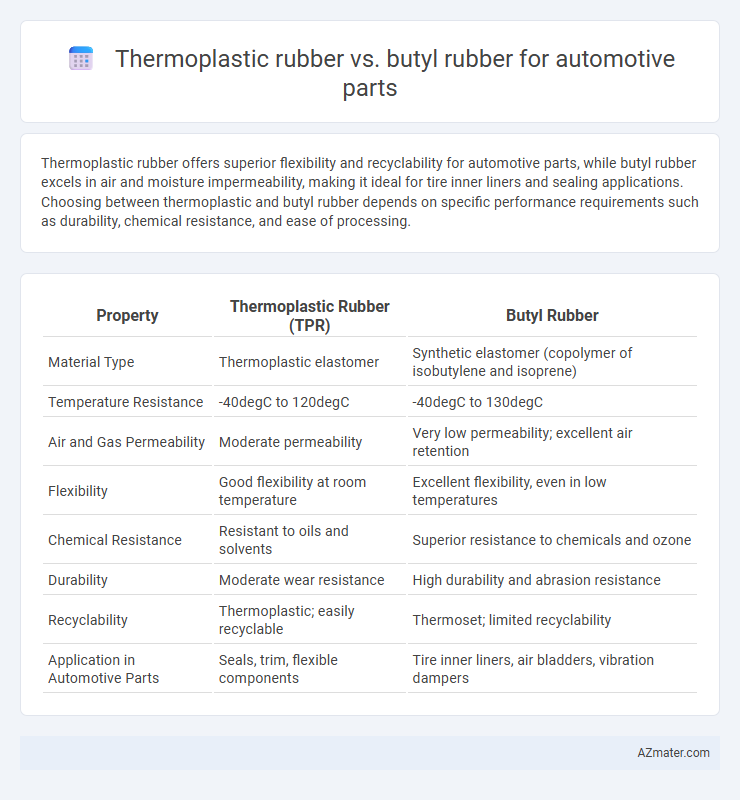Thermoplastic rubber offers superior flexibility and recyclability for automotive parts, while butyl rubber excels in air and moisture impermeability, making it ideal for tire inner liners and sealing applications. Choosing between thermoplastic and butyl rubber depends on specific performance requirements such as durability, chemical resistance, and ease of processing.
Table of Comparison
| Property | Thermoplastic Rubber (TPR) | Butyl Rubber |
|---|---|---|
| Material Type | Thermoplastic elastomer | Synthetic elastomer (copolymer of isobutylene and isoprene) |
| Temperature Resistance | -40degC to 120degC | -40degC to 130degC |
| Air and Gas Permeability | Moderate permeability | Very low permeability; excellent air retention |
| Flexibility | Good flexibility at room temperature | Excellent flexibility, even in low temperatures |
| Chemical Resistance | Resistant to oils and solvents | Superior resistance to chemicals and ozone |
| Durability | Moderate wear resistance | High durability and abrasion resistance |
| Recyclability | Thermoplastic; easily recyclable | Thermoset; limited recyclability |
| Application in Automotive Parts | Seals, trim, flexible components | Tire inner liners, air bladders, vibration dampers |
Introduction to Automotive Rubber Materials
Thermoplastic rubber (TPR) and butyl rubber are essential materials in automotive applications due to their unique properties. TPR offers excellent flexibility, impact resistance, and ease of processing, making it ideal for interior trims, seals, and flexible components. Butyl rubber excels in air retention, chemical resistance, and durability, commonly used in tire inner liners, vibration dampers, and weather-resistant seals.
Overview of Thermoplastic Rubber
Thermoplastic rubber (TPR) in automotive parts offers exceptional flexibility, excellent durability, and ease of processing compared to butyl rubber, enabling efficient mass production and recycling. TPR combines the elastic properties of rubber with the recyclability of plastics, enhancing performance in components such as seals, gaskets, and vibration dampers. Its resistance to abrasion, chemical exposure, and temperature variations makes it a versatile material choice in modern automotive manufacturing.
Overview of Butyl Rubber
Butyl rubber is a synthetic rubber known for its excellent impermeability to gases, making it ideal for automotive applications such as inner tubes, tire liners, and air bladders. Its superior resistance to heat, ozone, chemicals, and weathering ensures long-lasting durability in harsh automotive environments. Unlike thermoplastic rubber, butyl rubber offers enhanced airtightness and cushioning properties crucial for tire performance and noise reduction.
Key Performance Characteristics Comparison
Thermoplastic rubber (TPR) offers superior flexibility, impact resistance, and ease of recycling compared to butyl rubber, making it ideal for automotive parts requiring dynamic movement and environmental sustainability. Butyl rubber excels in air impermeability, chemical resistance, and thermal stability, which is critical for sealing applications like tires and inner tubes where long-term durability and airtight performance are essential. The choice between TPR and butyl rubber hinges on specific automotive component requirements, balancing flexibility and recyclability against impermeability and thermal resilience.
Durability and Weather Resistance
Thermoplastic rubber offers excellent flexibility and good abrasion resistance, making it suitable for automotive parts exposed to dynamic stresses. Butyl rubber excels in durability with superior resistance to ozone, UV radiation, and extreme weather conditions, ensuring long-lasting performance in harsh environments. Its low permeability to gases also provides enhanced sealing properties critical for automotive applications.
Flexibility and Elasticity Under Automotive Conditions
Thermoplastic rubber (TPR) exhibits superior flexibility under varying automotive temperatures, maintaining elasticity for extended durability in parts like seals and gaskets. Butyl rubber offers exceptional elasticity and impermeability, particularly resistant to heat, ozone, and aging, making it ideal for tire inner liners and vibration dampening components. Both materials are engineered to withstand automotive environmental stresses, but TPR provides enhanced flexibility in cold conditions while butyl rubber excels in long-term elasticity at elevated temperatures.
Chemical and Oil Resistance in Automotive Applications
Thermoplastic rubber (TPR) offers excellent flexibility and moderate chemical resistance, making it suitable for automotive parts exposed to mild oils and fluids, while butyl rubber excels in chemical and oil resistance, particularly against aggressive automotive fluids and fuels. Butyl rubber's superior impermeability to gases and resistance to acids and alkalis ensures enhanced durability in harsh automotive environments where chemicals and oils are prevalent. Selecting butyl rubber for seals and gaskets in fuel systems and TPR for interior components balances performance and cost in automotive applications.
Processing and Manufacturing Considerations
Thermoplastic rubber (TPR) offers easy processing through injection molding and extrusion, enabling faster cycle times and efficient recyclability in automotive part manufacturing. Butyl rubber, characterized by its excellent impermeability and chemical resistance, requires more complex curing processes like vulcanization, increasing production time and energy consumption. Manufacturers favor TPR for high-volume applications due to streamlined processing, while butyl rubber is preferred for parts demanding superior air retention and durability.
Cost Analysis: Thermoplastic Rubber vs Butyl Rubber
Thermoplastic rubber (TPR) offers cost advantages in automotive parts due to its recyclability and lower processing expenses compared to butyl rubber, which requires vulcanization and results in longer production cycles. Butyl rubber provides superior air impermeability and chemical resistance but incurs higher raw material costs and energy consumption during manufacturing. Overall, TPR reduces total lifecycle expenses through faster molding and lower scrap rates, making it a cost-effective choice for high-volume automotive applications.
Conclusion: Choosing the Right Rubber for Automotive Parts
Thermoplastic rubber offers excellent flexibility, recyclability, and resistance to abrasion, making it ideal for automotive parts requiring frequent deformation and environmental resilience. Butyl rubber provides superior air impermeability, chemical resistance, and durability, which is critical for seals and inner liners in tires. Selecting the right rubber depends on specific automotive applications, prioritizing thermoplastic rubber for flexible, lightweight components and butyl rubber for airtight, long-lasting sealing solutions.

Infographic: Thermoplastic rubber vs Butyl rubber for Automotive part
 azmater.com
azmater.com